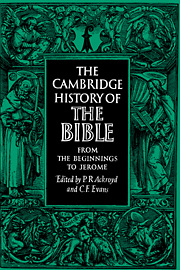Book contents
- Frontmatter
- I LANGUAGE AND SCRIPT
- II BOOKS IN THE ANCIENT WORLD
- III THE OLD TESTAMENT
- 5 THE OLD TESTAMENT IN THE MAKING
- 6 CANONICAL AND NON-CANONICAL
- 7 THE OLD TESTAMENT TEXT
- 8 BIBLE AND MIDRASH: EARLY OLD TESTAMENT EXEGESIS
- IV THE NEW TESTAMENT
- V THE BIBLE IN THE EARLY CHURCH
- Bibliography
- Abbreviations
- Notes on the Plates
- Indexes
- Plate Section">
- References
7 - THE OLD TESTAMENT TEXT
from III - THE OLD TESTAMENT
Published online by Cambridge University Press: 28 March 2008
- Frontmatter
- I LANGUAGE AND SCRIPT
- II BOOKS IN THE ANCIENT WORLD
- III THE OLD TESTAMENT
- 5 THE OLD TESTAMENT IN THE MAKING
- 6 CANONICAL AND NON-CANONICAL
- 7 THE OLD TESTAMENT TEXT
- 8 BIBLE AND MIDRASH: EARLY OLD TESTAMENT EXEGESIS
- IV THE NEW TESTAMENT
- V THE BIBLE IN THE EARLY CHURCH
- Bibliography
- Abbreviations
- Notes on the Plates
- Indexes
- Plate Section">
- References
Summary
We shall examine here the first stages in the history of the transmission of the Old Testament text over a period of approximately 500 years, starting with c. 300 B.C. For the preceding phases in the history of the text woefully little historical evidence is available, and none of it is contemporary. Any account of the development of the text prior to c. 300 B.C., i.e. in the Persian period, not to mention the periods of the Babylonian Exile or of the First Temple, must perforce rely upon conjecture and, at best, upon deductions and analogies derived from later literature and later manuscripts.
The beginning of what may properly be called the history of the Old Testament text roughly coincides with the final phases of the canonisation of the Old Testament books, a subject which has been discussed in the preceding section. During the period under review, the Jewish scribes and sages decided on, and carried out, the minute fixation of the consonantal text of the scriptures in the original Hebrew tongue. Concurrently, the Old Testament books were translated into other Semitic languages—Aramaic and Syriac—and also into non-Semitic languages—Greek, and subsequently Latin. This intense activity of editing and revising resulted, at the end of this period (first half of the third century A.D.), in the first comprehensive scholarly enterprise, Origen's Hexapla. In its six columns Origen presented a synoptic view of the then current Hebrew text of the Old Testament and its Greek translations: (1) The Hebrew Old Testament in Hebrew letters; (2) this same text transcribed in Greek letters; (3-6) the Greek versions of Aquila, Symmachus, the Septuagint and Theodotion.
Keywords
- Type
- Chapter
- Information
- The Cambridge History of the Bible , pp. 159 - 199Publisher: Cambridge University PressPrint publication year: 1970
References
- 6
- Cited by

